Android和Unity互调
Posted 大不懂
tags:
篇首语:本文由小常识网(cha138.com)小编为大家整理,主要介绍了Android和Unity互调相关的知识,希望对你有一定的参考价值。
目录
1.工具
androidStudio:
Android Gradle Plugin Version 3.5.2
Gradle Version 5.4.1
Unity 3D:
2018.4.30f1
2.流程 见下图
2.1 android 加载unity包
2.2 android 点击原生按钮调用unity方法,更新UnityUI
/**
* // objectName: Unity 对象的名称
* // methodName: Unity 对象绑定的脚本方法名
* // message: 自定义消息
*
*/
UnityPlayer.UnitySendMessage("Canvas/Button_Show", "ShowText", "Android 数据");2.3 Unity 点击unity内部按钮调用android方法更新AndroidUI,Android响应被调回应数据,unity回去数据更新UnityUi
AndroidJavaClass jc = new AndroidJavaClass("com.unity3d.player.UnityPlayer");
AndroidJavaObject jo = jc.GetStatic<AndroidJavaObject>("currentActivity");
//传入方法名 参数
string v = jo.Call<string>("CallAndroidShow","Unity 数据");
//如果没有返回
jo.Call("CallAndroidShow");3.具体过程
3.1 unity程序编写
3.1.1 创建Unity项目
创建一个3D项目 版本是2018.4.30f1

3.1.2 制作相关控件
添加两个控件:
1.text name:Text1
2.button name:Button_Show

3.1.3 编写脚本
编写一个脚本:ShowButton.cs。并挂载在Button_Show控件上
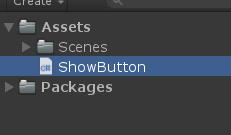
脚本内容:
using System.Collections;
using System.Collections.Generic;
using UnityEngine;
using UnityEngine.UI;
public class ShowButton : MonoBehaviour
{
public Text textShow;
public Button show;
//Start is called before the first frame update
//点击unity按钮后调用android方法
public void CallAndroidShowAa()
{
// 不知道为啥不行
//AndroidJavaClass jo = new AndroidJavaClass("com.unity2android.unityplugin.AndroidActivity");
//jo.Call("CallAndroidShow");
show.transform.Find("Text").GetComponent<Text>().text = "调取Android数据";
AndroidJavaClass jc = new AndroidJavaClass("com.unity3d.player.UnityPlayer");
AndroidJavaObject jo = jc.GetStatic<AndroidJavaObject>("currentActivity");
//传入方法名 参数
string v = jo.Call<string>("CallAndroidShow","Unity 数据");
textShow.text = v;
}
//提供一个android调用的方法 android调用传入数据unity更新UI
public void ShowText(string message)
{
textShow.text = "" + message;
}
// Start is called before the first frame update
void Start()
{
//点击事件
show.onClick.AddListener(CallAndroidShowAa);
}
// Update is called once per frame
void Update()
{
}
}
挂在后将控件传入脚本:
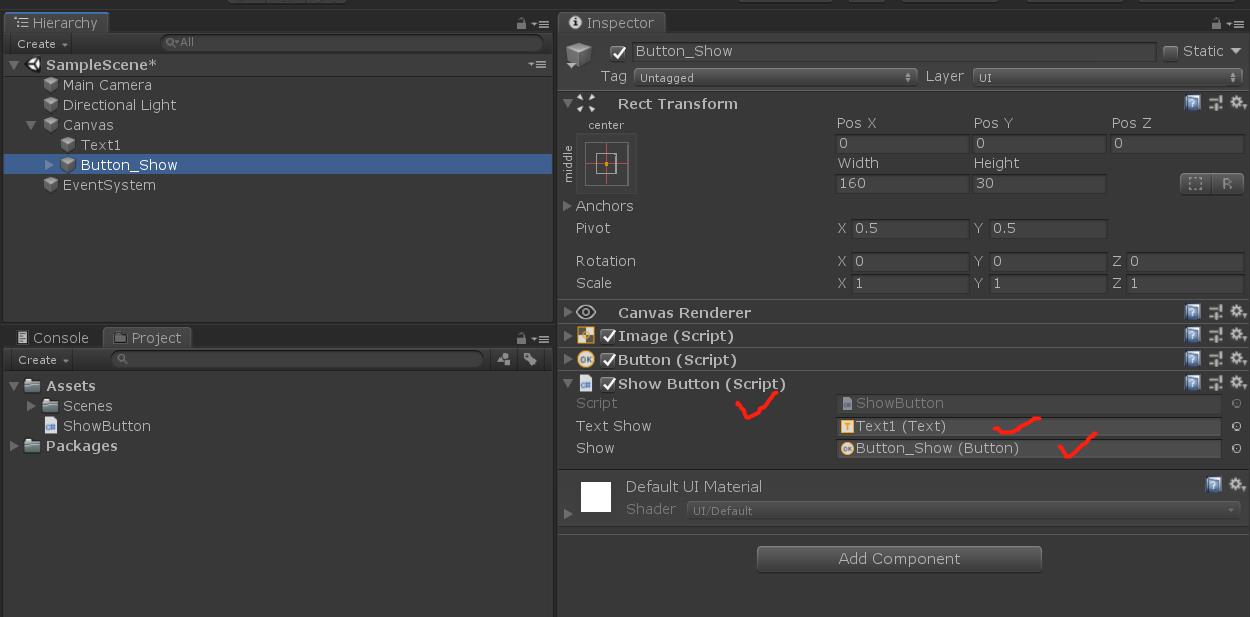
3.2 unity 项目导出
3.2.1 External Tools 的设置
路径:Edit->Preferences->External Tools
SDK、JDK、NDK 都需要勾选如果本地有用本地的比较快,
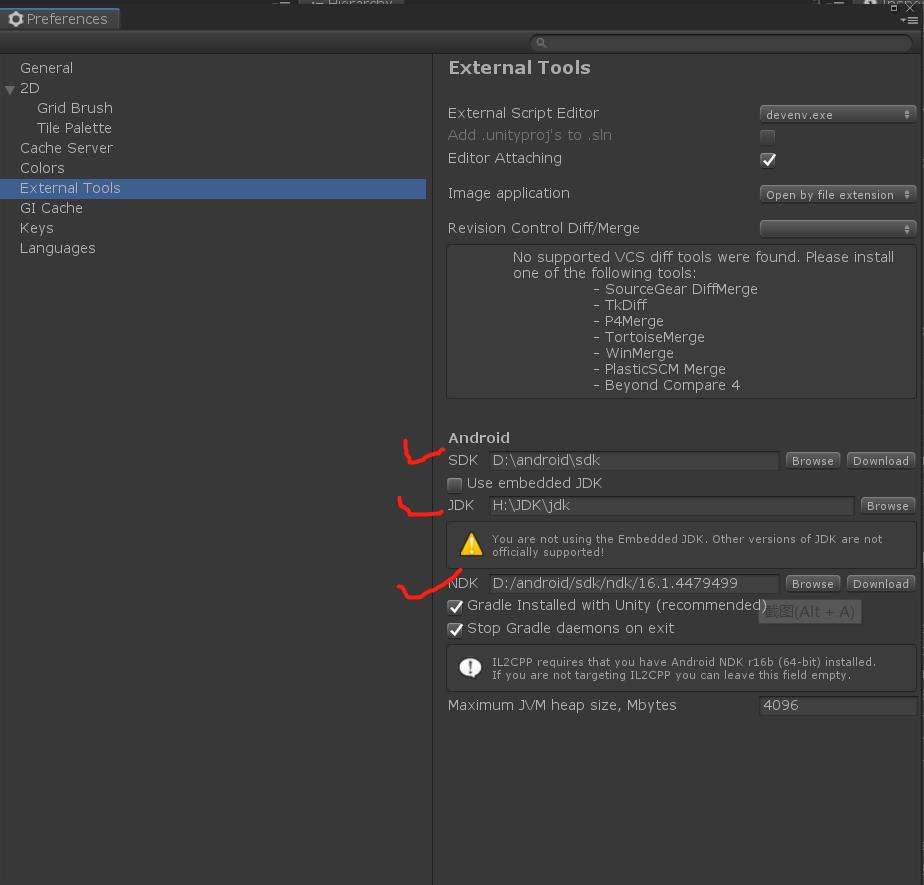
3.2.2 Player Settings的设置
路径:File->BuildSettings->Player Settings
1.修改Company name和Product Name 涉及后面的包名

2.版本修改
package name 是和 Company name、Product Name关联的
version和bundle version Code我猜一个是真正的版本号一个是显示的版本号,这个可以不改,但是继承的时候如果有更改unity不改再集成会报错,不知道为啥。
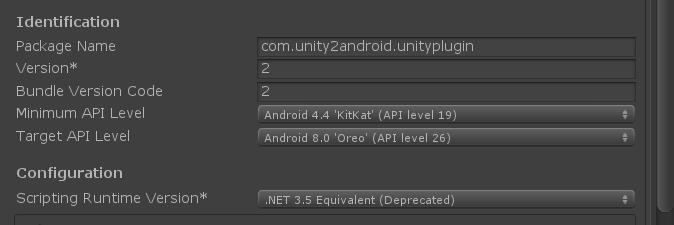
3.cpu架构的选择
如果不选择X86就不用Scriptiong Backend选择IL2CPP。

3.2.3 导出
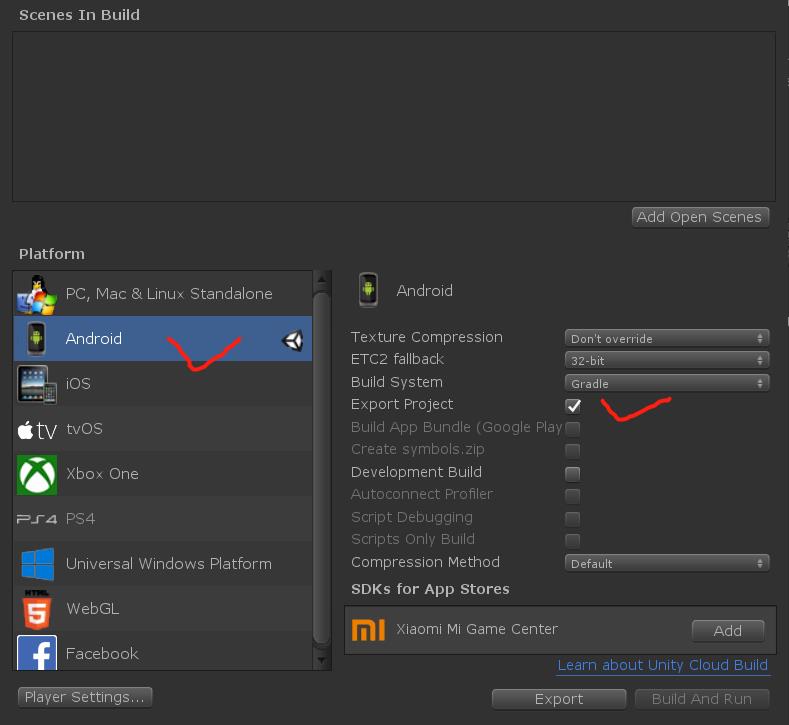
漫长的等待。
3.3 Android项目集成
3.3.1 创建项目
这个包名要和unity导出的一致

3.3.2 集成unity
3.3.2.1 查看unity 导出的结构

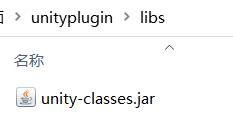
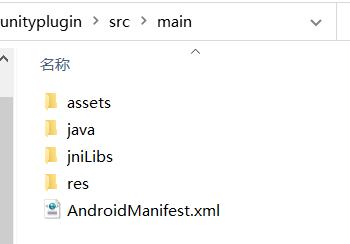
3.3.2.2 集成jar
将unity 3D导出的jar复制到android项目下,
Project->unityplugin->app->libs
右键 add As Library

3.3.2.3 集成assets
将unity包中的assets复制到APP->src->main下
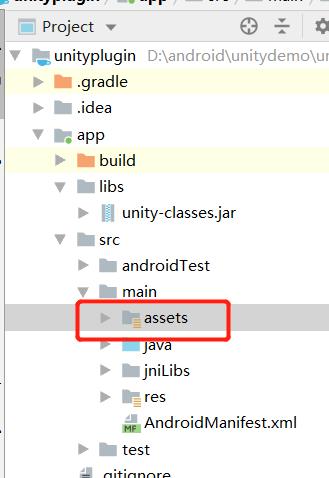
3.3.2.4 集成jniLibs
将unity 导出包中的jinLibs全部复制到APP->src->main下
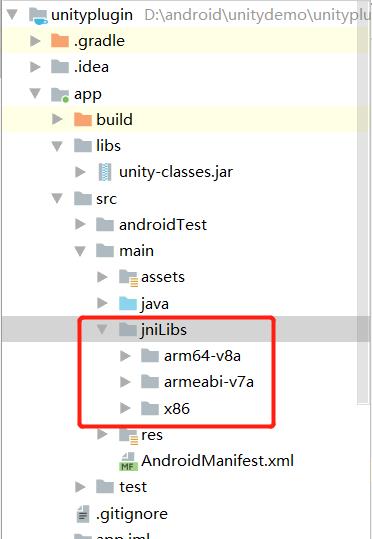
3.3.2.5 修改清单文件
将unity包中的清单文件打开,把android项目中清单文件不包含的全部粘贴过去其中
<activity android:name="com.unity2android.unityplugin.UnityPlayerActivity">修改为自己项目路径,里面的
<intent-filter> <action android:name="android.intent.action.MAIN" /> <category android:name="android.intent.category.LAUNCHER" /> <category android:name="android.intent.category.LEANBACK_LAUNCHER" /> </intent-filter>
需要屏蔽掉
<?xml version="1.0" encoding="utf-8"?>
<manifest xmlns:android="http://schemas.android.com/apk/res/android"
xmlns:tools="http://schemas.android.com/tools"
package="com.unity2android.unityplugin"
android:installLocation="preferExternal">
<supports-screens
android:anyDensity="true"
android:largeScreens="true"
android:normalScreens="true"
android:smallScreens="true"
android:xlargeScreens="true" />
<application
android:banner="@drawable/app_banner"
android:icon="@mipmap/app_icon"
android:isGame="true"
android:label="@string/app_name"
android:theme="@style/UnityThemeSelector">
<!-- 修改为 android:name="com.unity3d.player.UnityPlayerActivity">-->
<activity
android:name="com.unity2android.unityplugin.UnityPlayerActivity">
android:configChanges="mcc|mnc|locale|touchscreen|keyboard|keyboardHidden|navigation|orientation|screenLayout|uiMode|screenSize|smallestScreenSize|fontScale|layoutDirection|density"
android:hardwareAccelerated="false"
android:label="@string/app_name"
android:launchMode="singleTask"
android:screenOrientation="fullSensor">
<!-- 屏蔽掉-->
<intent-filter>
<action android:name="android.intent.action.MAIN" />
<category android:name="android.intent.category.LAUNCHER" />
<category android:name="android.intent.category.LEANBACK_LAUNCHER" />
</intent-filter>
<meta-data
android:name="unityplayer.UnityActivity"
android:value="true" />
</activity>
<meta-data
android:name="unity.build-id"
android:value="487dc281-c378-4b43-9120-9f3bb7741898" />
<meta-data
android:name="unity.splash-mode"
android:value="0" />
<meta-data
android:name="unity.splash-enable"
android:value="True" />
<meta-data
android:name="unity.builder"
android:value="\\12369984484064" />
</application>
<uses-feature android:glEsVersion="0x00020000" />
<uses-permission android:name="android.permission.INTERNET" />
<uses-feature
android:name="android.hardware.touchscreen"
android:required="false" />
<uses-feature
android:name="android.hardware.touchscreen.multitouch"
android:required="false" />
<uses-feature
android:name="android.hardware.touchscreen.multitouch.distinct"
android:required="false" />
<uses-permission android:name="android.permission.ACCESS_NETWORK_STATE" />
</manifest>3.3.2.6修改相关配置文件
将unity 中build.gradle文件下的补全到android项目中的build.gradle中

Android项目的Project
// Top-level build file where you can add configuration options common to all sub-projects/modules.
buildscript {
repositories {
mavenCentral()
google()
jcenter()
}
dependencies {
classpath 'com.android.tools.build:gradle:3.5.2'
// NOTE: Do not place your application dependencies here; they belong
// in the individual module build.gradle files
}
}
allprojects {
repositories {
mavenCentral()
google()
jcenter()
flatDir {
dirs 'libs'
}
}
}
task clean(type: Delete) {
delete rootProject.buildDir
}
Andorid 项目的mode
apply plugin: 'com.android.application'
android {
compileSdkVersion 30
buildToolsVersion "30.0.0"
defaultConfig {
applicationId "com.unity2android.unityplugin"
minSdkVersion 19
targetSdkVersion 30
versionCode 1
versionName "1.0"
ndk {
abiFilters 'armeabi-v7a', 'arm64-v8a', 'x86'
}
testInstrumentationRunner "androidx.test.runner.AndroidJUnitRunner"
}
lintOptions {
abortOnError false
}
aaptOptions {
noCompress = ['.unity3d', '.ress', '.resource', '.obb']
}
compileOptions {
sourceCompatibility JavaVersion.VERSION_1_8
targetCompatibility JavaVersion.VERSION_1_8
}
buildTypes {
debug {
minifyEnabled false
useProguard false
proguardFiles getDefaultProguardFile('proguard-android.txt'), 'proguard-unity.txt'
jniDebuggable true
}
release {
minifyEnabled false
useProguard false
proguardFiles getDefaultProguardFile('proguard-android.txt'), 'proguard-unity.txt'
signingConfig signingConfigs.debug
}
}
packagingOptions {
doNotStrip '*/armeabi-v7a/*.so'
doNotStrip '*/arm64-v8a/*.so'
doNotStrip '*/x86/*.so'
}
bundle {
language {
enableSplit = false
}
density {
enableSplit = false
}
abi {
enableSplit = true
}
}
}
dependencies {
implementation fileTree(include: ['*.jar'], dir: 'libs')
implementation 'androidx.appcompat:appcompat:1.0.2'
implementation 'androidx.constraintlayout:constraintlayout:1.1.3'
testImplementation 'junit:junit:4.12'
androidTestImplementation 'androidx.test.ext:junit:1.1.0'
androidTestImplementation 'androidx.test.espresso:espresso-core:3.1.1'
implementation files('libs/unity-classes.jar')
}
没有啥补啥
3.4 Android项目调用
新建一个AndroidActivity
package com.unity2android.unityplugin;
import android.app.Activity;
import android.content.Intent;
import android.os.Bundle;
import android.util.Log;
import android.view.KeyEvent;
import android.view.MotionEvent;
import android.view.View;
import android.widget.Button;
import android.widget.LinearLayout;
import android.widget.TextView;
import com.unity2android.unityplugin.R;
import com.unity3d.player.UnityPlayer;
import com.unity3d.player.UnityPlayerActivity;
import static android.content.ContentValues.TAG;
public class AndroidActivity extends UnityPlayerActivity {
private TextView tv;
private LinearLayout ll;
@Override
protected void onCreate(Bundle savedInstanceState) {
super.onCreate(savedInstanceState);
setContentView(R.layout.activity_android);
ll = findViewById(R.id.ll);
ll.addView(mUnityPlayer);
Button switch_ = findViewById(R.id.switch_);
Button clear = findViewById(R.id.clear);
tv = findViewById(R.id.tv);
switch_.setOnClickListener(new View.OnClickListener() {
@Override
public void onClick(View v) {
CallUnityShow("Canvas/Button_Show", "ShowText", "Android 数据");
}
});
clear.setOnClickListener(new View.OnClickListener() {
@Override
public void onClick(View v) {
CallUnityShow("Canvas/Button_Show", "ShowText", "");
tv.setText("");
}
});
ll.setOnClickListener(new View.OnClickListener() {
@Override
public void onClick(View v) {
Log.d(TAG, "onClick: lll");
}
});
}
/**
* // objectName: Unity 对象的名称
* // methodName: Unity 对象绑定的脚本方法名
* // message: 自定义消息
*
* @param s1
* @param s2
* @param s3
*/
public void CallUnityShow(String s1, String s2, String s3) {
UnityPlayer.UnitySendMessage(s1, s2, s3);
Log.d(TAG, "CallUnityShow: 456");
}
public String CallAndroidShow(final String s) {
Log.d(TAG, "CallAndroidShow: 123");
runOnUiThread(new Runnable() {
@Override
public void run() {
tv.setText(s);
}
});
return "Android 返回";
}
@Override
protected void onDestroy() {
super.onDestroy();
// UnityPlayer.UnitySendMessage("Manager", "Unload", "");
mUnityPlayer.quit();
}
// Pause Unity
@Override
protected void onPause() {
super.onPause();
mUnityPlayer.pause();
}
// Resume Unity
@Override
protected void onResume() {
super.onResume();
mUnityPlayer.resume();
}
/**
* 按键点击事件
*/
@Override
public boolean onKeyDown(int keyCode, KeyEvent event) {
if (keyCode == KeyEvent.KEYCODE_BACK) {
onDestroy();
}
return true;
}
}对应的xml:
<?xml version="1.0" encoding="utf-8"?>
<LinearLayout xmlns:android="http://schemas.android.com/apk/res/android"
xmlns:app="http://schemas.android.com/apk/res-auto"
xmlns:tools="http://schemas.android.com/tools"
android:layout_width="match_parent"
android:layout_height="match_parent"
android:orientation="vertical">
<LinearLayout
android:id="@+id/ll"
android:layout_width="match_parent"
android:layout_height="400dp"
android:orientation="vertical"></LinearLayout>
<LinearLayout
android:layout_width="wrap_content"
android:orientation="horizontal"
android:layout_height="wrap_content">
<Button
android:id="@+id/switch_"
android:layout_width="wrap_content"
android:layout_height="wrap_content"
android:text="text"/>
<Button
android:id="@+id/clear"
android:layout_width="wrap_content"
android:layout_height="wrap_content"
android:text="clear"/>
</LinearLayout>
<TextView
android:id="@+id/tv"
android:layout_width="wrap_content"
android:layout_height="wrap_content"
android:text="unity"/>
</LinearLayout>
Android项目源码:https://download.csdn.net/download/qq_35698774/19990943
Unity 导出的jar:https://download.csdn.net/download/qq_35698774/19990999
Unity 项目:https://download.csdn.net/download/qq_35698774/19991018
以上是关于Android和Unity互调的主要内容,如果未能解决你的问题,请参考以下文章
